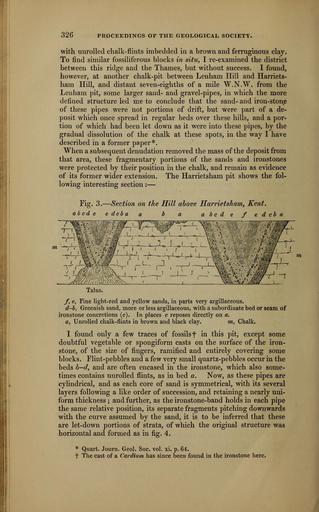MAKE A MEME
View Large Image

| View Original: | The_Quarterly_journal_of_the_Geological_Society_of_London_(12826412333).jpg (1296x2077) | |||
| Download: | Original | Medium | Small | Thumb |
| Courtesy of: | commons.wikimedia.org | More Like This | ||
| Keywords: The Quarterly journal of the Geological Society of London (12826412333).jpg 326 <br> PROCEEDINGS OF THE GEOLOGICAL SOCIETY <br> with unrolled chalk-flints imbedded in a brown and ferruginous clay <br> To find similar fossiliferous blocks in situ I re-examined the district <br> between this ridge and the Thames but without success I found <br> however at another chalk-pit between Lenham Hill and Harriets- <br> ham Hill and distant seven-eighths of a mile W N W from the <br> Lenham pit some larger sand- and gravel-pipes in which the more <br> defined structure led me to conclude that the sand- and iron-stone <br> of these pipes were not portions of drift but were part of a de- <br> posit which once spread in regular beds over these hills and a por- <br> tion of which had been let down as it were into these pipes by the <br> gradual dissolution of the chalk at these spots in the way I have <br> described in a former paper <br> When a subsequent denudation removed the mass of the deposit from <br> that area these fragmentary portions of the sands and ironstones <br> were protected by their position in the chalk and remain as evidence <br> of its former wider extension The Harrietsham pit shows the fol- <br> lowing interesting section � <br> Fig 3 � Section on the Hill above Harrietsham Kent <br> abode edcba a b a a bed e f e deba <br> x7 I ��» \ r v 7 <br> X ' r Km ' <br> Talus <br> f e Fine light-red and yellow sands in parts very argillaceous <br> d-b Greenish sand more or less argillaceous with a subordinate bed or seam of <br> ironstone concretions e In places c reposes directly on a <br> a Unrolled chalk-flints in brown and black clay m Chalk <br> I found only a few traces of fossils f in this pit except some <br> doubtful vegetable or spongiform casts on the surface of the iron- <br> stone of the size of fingers ramified and entirely covering some <br> blocks Flint-pebbles and a few very small quartz-pebbles occur in the <br> beds b-d and are often encased in the ironstone which also some- <br> times contains unrolled flints as in bed a Now as these pipes are <br> cylindrical and as each core of sand is symmetrical with its several <br> layers following a like order of succession and retaining a nearly uni- <br> form thickness ; and further as the ironstone-band holds in each pipe <br> the same relative position its separate fragments pitching downwards <br> with the curve assumed by the sand it is to be inferred that these <br> are let-down portions of strata of which the original structure was <br> horizontal and formed as in fig 4 <br> Quart Journ Geol Soc vol xi p 64 <br> f The cast of a Cardium has since been found in the ironstone here 36214300 111684 51125 Page 326 Text v 14 http //www biodiversitylibrary org/page/36214300 1858 Geological Society of London NameFound Cardium NameConfirmed Cardium EOLID 50301 NameBankID 2693257 Biodiversity Heritage Library The Quarterly journal of the Geological Society of London v 14 1858 Geology Periodicals Smithsonian Libraries bhl page 36214300 dc identifier http //biodiversitylibrary org/page/36214300 smithsonian libraries Information field Flickr posted date ISOdate 2014-02-28 Check categories 2015 August 26 CC-BY-2 0 BioDivLibrary https //flickr com/photos/61021753 N02/12826412333 2015-08-26 17 52 36 cc-by-2 0 PD-old-70-1923 The Quarterly journal of the Geological Society of London 1858 Photos uploaded from Flickr by Fæ using a script | ||||